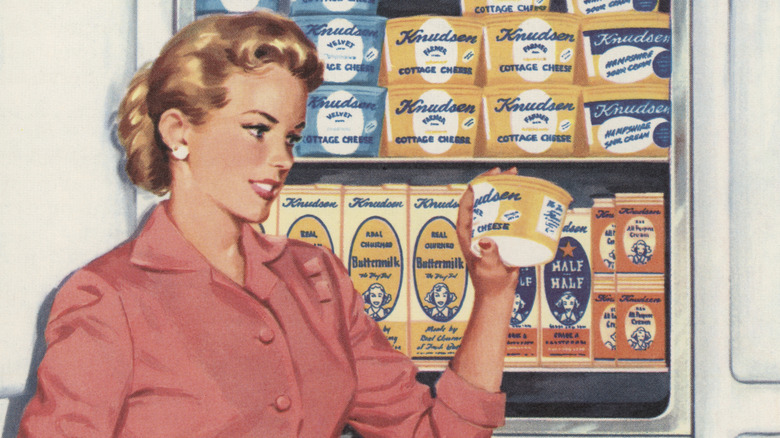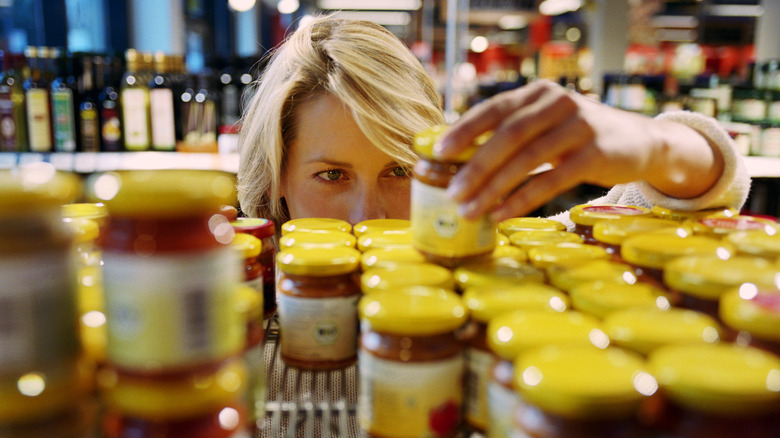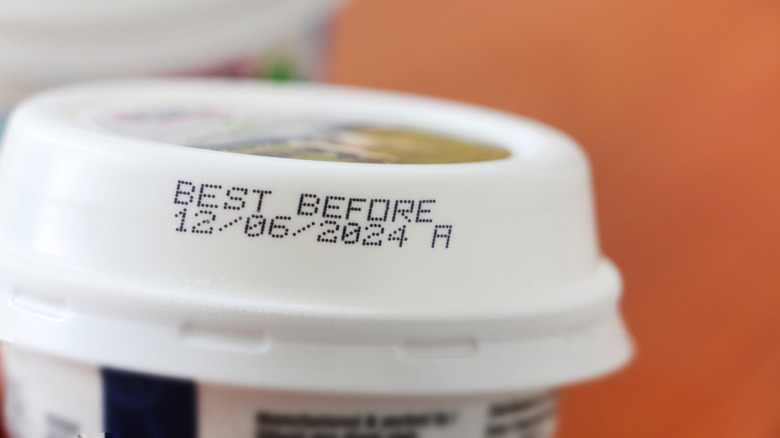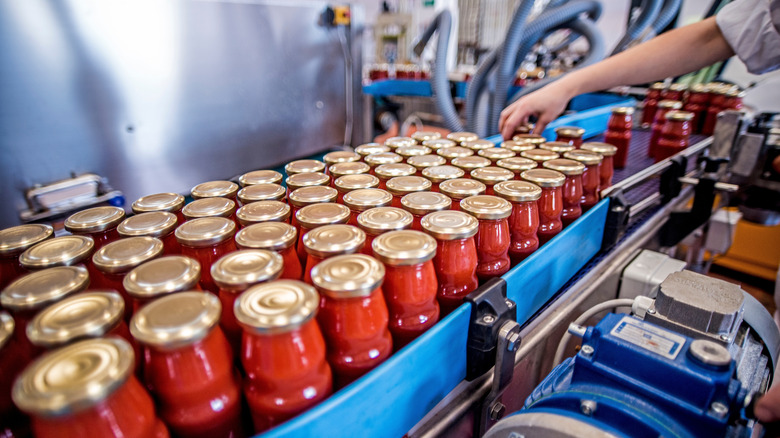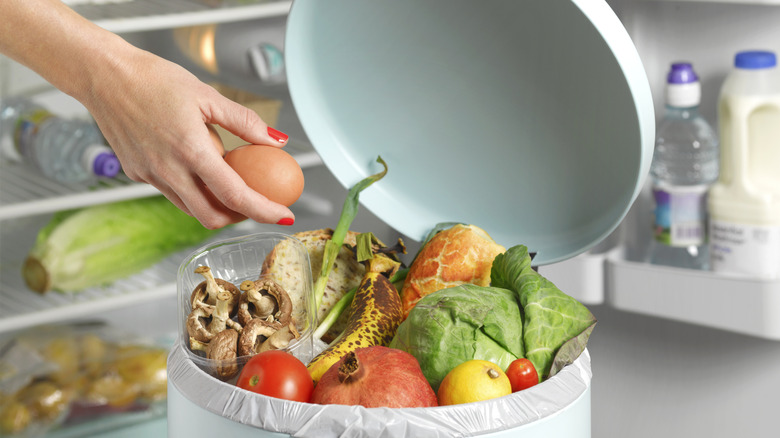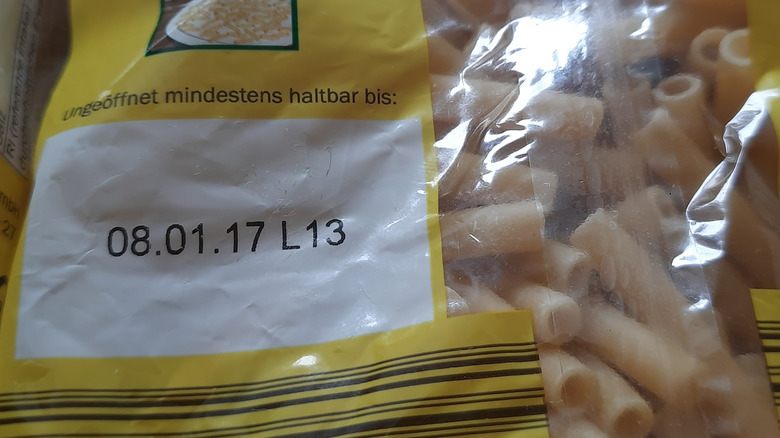A Guide To Food Expiration Dates
Maybe you're the type to look at a date on the bottom of a can or the side of a box and, no matter if the words say "best by," "use by," or anything in between, if the date's passed, you're tossing that food in the trash. Maybe you're the type to skeptically raise an eyebrow at those dates, though, and you'd rather rely on the ol' sniff test to see if your food's truly past its prime.
There are pros and cons to both of these methods. On one hand, keeping some foods past so-called expiration dates could keep you from wasting food and, thus, money. On the other hand, sometimes ignoring those expiration dates could mean that you put you and your family at risk for food poisoning — and when food poisoning can lead to serious gastrointestinal distress, hospitalization, and even death, that's not something you want to play around with.
So how do you make better decisions around when and why to throw out expired foods? It helps to first get a good handle on how food expiration dates were developed, how to read them, and when you can usually ignore them. Here's what you need to know.
The history of food expiration dates
But where did these food expiration dates even come from? Before the advent of canned and packaged foods, it's not like your great-great-great grandparents were looking down at stamped dates on a cloth bag of flour from the local mill. So when did society decide that our foods needed to come with a warning regarding their longevity?
The origins of food expiration dates are a bit murky. There's one oft-told story about Chicago gangster Al Capone and how a family member fell ill after drinking expired milk, prompting Capone to push local lawmakers to require milk processors date their milk. However, the more standard method of placing food expiration dates on packaging really became popular in the 1970s. Around this decade, manufacturers were already putting coded processing dates on their packaging, but these codes were for the sellers' benefits, not the consumers'. Then, as more and more consumers began wondering about the ingredients in their foods and how fresh they were, and as grocery store purchases began to largely take the place of fresh, traceable food within the typical home, consumers demanded that these coded expiration dates become easily readable to the average person. As such, manufacturers began putting what's called "open dating" codes on their products, with clearly displayed expiration dates on labels.
How to read food expiration dates
Don't just assume that reading a food expiration date is as simple as looking at a day, month, and year stamped on a package. Yes, while you'd expect that the expiration date would be a straightforward day on the calendar, at which point you can safely assume your food is no longer suitable for consumption, expiration dates are a little more complicated and convoluted than that.
As mentioned, manufacturers only switched to what's known as "open dating" best-by stamps after consumer demand in the 1970s. However, they still use the prior "closed dating" method as well. This closed dating method is most popular on canned goods and consists of a combination of letters and numbers that tell manufacturers when the product was manufactured. Since these codes are not intended for consumers, they'll mean little to you (unless there's a food recall, in which case manufacturers may release the affected foods' closed dating code so that consumers can identify whether they own an affected package and then throw it out).
Beyond these closed date stamps, you'll also, though, see an open dated stamp, which will either be a very clear date, or a series of numbers. In the former case, you might see a stamp that says "BEST BY NOV 27 25." In the latter case, if it's just a series of numbers, the numbers will be formatted as MMDDYY, or month, date, and year. So, again, if the product expires on Nov. 27, 2025, the MMDDY stamp would read "112725."
What is the difference between sell by and best by expiration dates?
Beyond just some dates and/or numbers, though, you'll also see some differing verbiage accompanying these expiration dates. Typically, a product will be marked with "Sell by," "Best by/before," "Use by," and/or "Freeze by," and all of these mean slightly different things.
If a product says "best by" before the associated date, that means that the product will simply be at its highest quality up until that date. It doesn't mean that the product is unsafe to use after that date. It just might not be as tasty as it was prior. If a product says "sell by" before the associated date, that just means that the store should only keep the product out on the shelf until that date. Again, it doesn't at all mean the product is unsafe to eat after that date has passed.
If a product says "use by" before the associated date, again, it's another suggestion related to quality. The only time that a "use by" date is directly related to safety is when it applies to infant formula. Lastly, if a product says "freeze by" before the associated date, it's just a suggestion that you freeze the product by that date in order to retain the highest quality. The product, though, will not be necessarily unsafe to eat after that date.
Who regulates food expiration dates?
The U.S. government does not require that manufacturers put any sort of expiration dates on their foods. The only instance wherein this is not the case is when it comes to infant formula, which the federal government does regulate. So, if a manufacturer puts an expiration date on their product, it's entirely because they want to.
That said, the U.S. Food Safety and Inspection Service does require that, if a manufacturer chooses to use a "best by" or similar stamp on their product, that the stamp meet certain standards. The date must include a month and day on all foods, and also a year on shelf-stable and frozen items. The stamp must also include "best by," "sell by," "use by," and/or "freeze by."
However, while the above is the case on a federal level, some states do more directly oversee food expiration dates. Forty-one states and the District of Columbia all require some sort of food date labeling, but the requirements differ significantly from state to state.
Do most people ignore food expiration dates?
If you've made it this far, then you're probably scratching your head and wondering, "If none of the verbiage used for expiration dates really means that a food is unsafe to eat after a certain time, and if no one governing body is overseeing expiration dates, do they really even matter?" The answer, for some consumers, is "no."
A large portion of the population will eat an "expired" food if and when it makes sense. As reported by Food Dive, one survey in 2022 that looked at ways consumers were saving money on food, found that, in order to do so, more were eating foods past their "best by" or similar dates. More than half of survey respondents said they'd eat potato chips and similar snacks, as well as cereal, past expiration dates. About 48% said they'd eat candy and cookies even once the expiration date had passed. Similarly, a 2024 Reddit thread discussed foods that people frequently eat after the expiration date has passed, with pantry items like spices, rice, barley, lentils, dried beans, condiments, canned food, and even eggs and cheese noted as common "expired" foods that respondents eat on the regular.
Do expiration dates only benefit the food manufacturer?
So if expiration dates don't really benefit the consumer in any real way (beyond perhaps providing a bit of peace of mind to the particularly cautious individual), what's the point? Some may say that expiration dates exist today to benefit, primarily, the food manufacturer.
For one, if a food manufacturer can get you to eat a food before a "best by" date, while the food is at its peak quality, then it's more likely that you're going to actually enjoy the food. It's the difference between eating a fresh cookie and a stale cookie, for example. If you enjoyed that food, you'll probably buy it a second time.
Additionally, if some consumers wholeheartedly believe that a "best by" date is the date when a food is no longer safe to eat, they'll be likely to throw the food out once that date passes — at which point they're more likely to buy the food again, if it's a necessity that they use regularly, like milk or eggs.
How safe is food after the expiration date passes?
If most expiration dates primarily refer to whether or not a food is still at its highest quality, how safe is it to actually eat food after the expiration date has passed? It all depends on one big factor: how you stored the food once you got it home from the grocery store. If you followed best storage practices, most food will still be fine for a time after that expiration date passes.
For example, if you're dealing with perishable items like meat, eggs, or dairy, you need to refrigerate or freeze those items as soon as you get them home. Your fridge should always be kept at or below 40 F. Your freezer should always be below freezing.
For shelf-stable foods, like canned items, keep the food in a cool, dry spot, away from heat and direct sunlight. This means not keeping your pantry items on the countertop where the morning sun directly beams in through the kitchen window. It also means not storing food in a cabinet over or beside your stove. Also avoid storing these foods in moist, damp places, like a basement or garage.
Can food go bad before the expiration date?
Along the above lines, if the speed at which food goes bad is directly impacted by how you store and handle the food at home, that means that not only can food stay good past the expiration date, but it can also go bad before the expiration date.
The primary factors that make food go bad before its time include moisture, warm temperatures and the presence of bacteria, mold, and/or yeast. When you create the right environment (such as a moist, warm environment) for bacteria, mold, and/or yeast to thrive, your food is going to go bad far sooner than it would otherwise.
Additionally, some foods just naturally go bad quicker than others, so you may find that they're bad before the expiration date passes. This is the case with raw fish and beef, deli meats, milk, and baked goods. For example, if you open a pack of ground beef and don't use it all, the leftover ground beef, unless frozen, probably won't last as long as the original "best by" date. The same can happen to deli meat that's not stored in an airtight container, as well as milk that's stored in the refrigerator door, versus on a shelf, as food stored in the fridge door is susceptible to fluctuating temperatures.
How do expiration dates impact food waste?
Unfortunately, expiration dates result in a large amount of food waste, with expiration date diehards tossing food the minute it ticks past "best by" territory. In fact, according to CNN, the Food and Drug Administration has reported that following expiration dates leads to about 20% of household food waste within the United States — and the United States throws out a huge amount of food. One 2023 study found that Americans throw out 120 billion pounds of food per annum, or 325 pounds per person. This means that 40% of the food produced in the United States is thrown out.
This food waste has far-reaching impacts, beyond just wasted money (which totals about $1,300 per year per person, according to the Harvard Law School Center for Health Law and Policy Innovation). According to the United Nations, food waste can take credit for 8% of all international greenhouse gas emissions, as that discarded food rots away in a landfill. To help mitigate these issues, the U.S. Department of Agriculture stresses the importance of consumers knowing that expiration dates are for quality purposes primarily, and they do not reflect a food's safety past a certain date.
Do other countries use expiration dates?
Is the problem of confusing expiration dates exclusively an American thing? Not necessarily. Other countries have their own unique relationships with expiration dates and the expiration-related phrases that are used on products in the United States can mean very different things in other countries.
For example, according to the European Food Information Council, whereas a "use by" date only concerns quality, not safety, in the United States, that's not the case in Europe. Instead, in European countries, while a "best by" date still refers to when the food will be past its peak quality, a "use by" date indicates that a food is very much not safe to eat after that date passes. In Europe, "use by" dates are only on foods that are considered high-risk and very perishable, such as fresh meat, dairy, and ready-to-eat foods. However, in the United Kingdom, some grocery stores are removing "best before" dates from their products in order to reduce food waste, including "best before" dates on produce, a commonly wasted food.
When should you really throw away food?
So when is it really time to throw out your food, even if you haven't opened the package just yet? There are some signs that you should look for that could indicate that your food has spoiled, regardless of what any date on the packaging says, and whether or not that date has passed just yet.
First, look for obvious signs of spoilage, such as mold or mildew. You can also sniff certain pantry items to tell if they've gone rancid, including nuts, seeds, crackers, or cookies. Once you've smelled a rancid food item once, you'll likely be able to identify a rancid food forever, but if you've never had the pleasure, basically a rancid food smells slightly bitter and metallic.
It's harder to tell if some foods have gone bad, though, as is the case with canned and frozen food. While canned food can last years without going bad, you should throw it away if it's badly dented (meaning the dent has sharp edges or you can lay your finger in the dent), bulging, rusted, or visibly leaking. Frozen food, which can last indefinitely under the right conditions, should likewise be thrown out if it's exposed to warm temperatures for more than two hours.
What foods never expire?
While canned food will last a while before going bad, some foods, like frozen food, can truly last nearly forever if you treat them correctly. Honey is pretty reliably safe for decades, as are dried beans and most rice. Vinegar, as a natural preservative, likewise doesn't spoil easily. If you don't open certain condiments, they can last indefinitely, too. These include soy sauce and Worcestershire sauce, due to the naturally preserving ingredients included in both. Cornstarch and sugar can last indefinitely and, while they can't quite last a decade like honey, beans, and rice, both dehydrated vegetables and canned fish can last multiple years before getting iffy.
As mentioned, you do want to ensure that you're storing all foods safely, for the longest shelf life possible and the greatest quality possible. However, taking just small precautions like not storing your food in places subject to extreme temperatures, or in sunny or moist environments, can ensure you're not beholden to expiration dates that may or may not offer any truly useful information.

